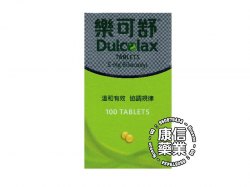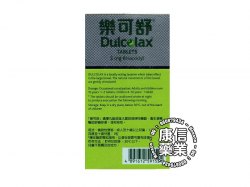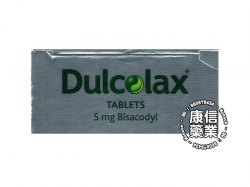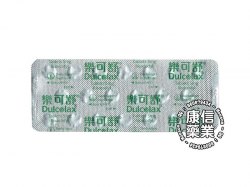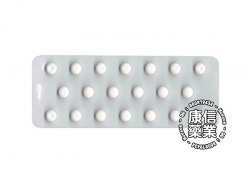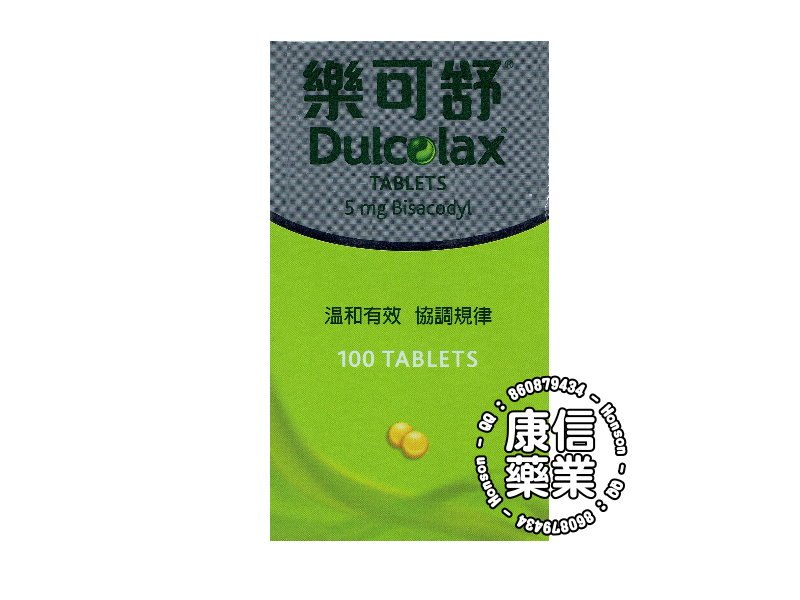
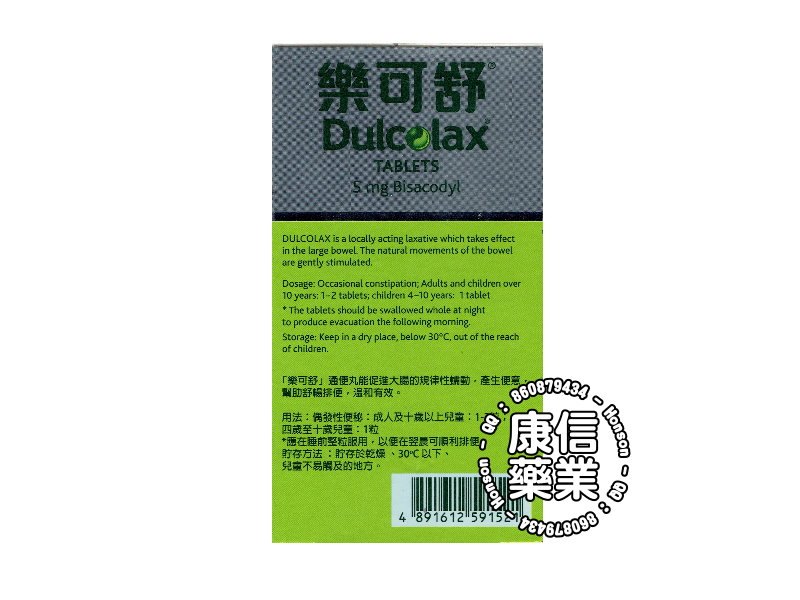
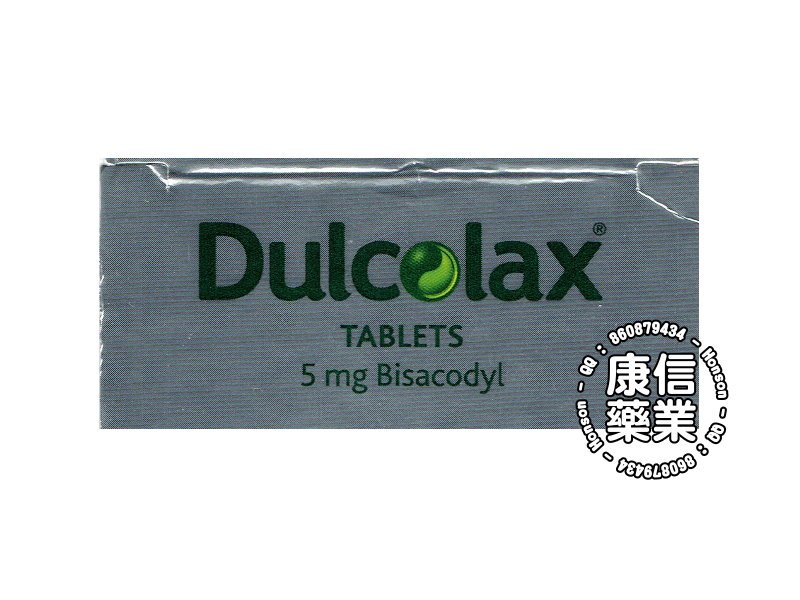
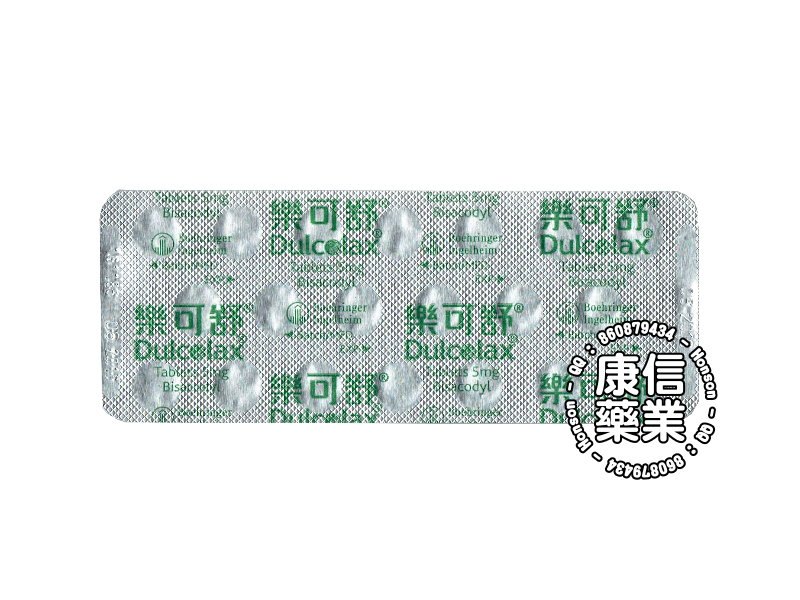
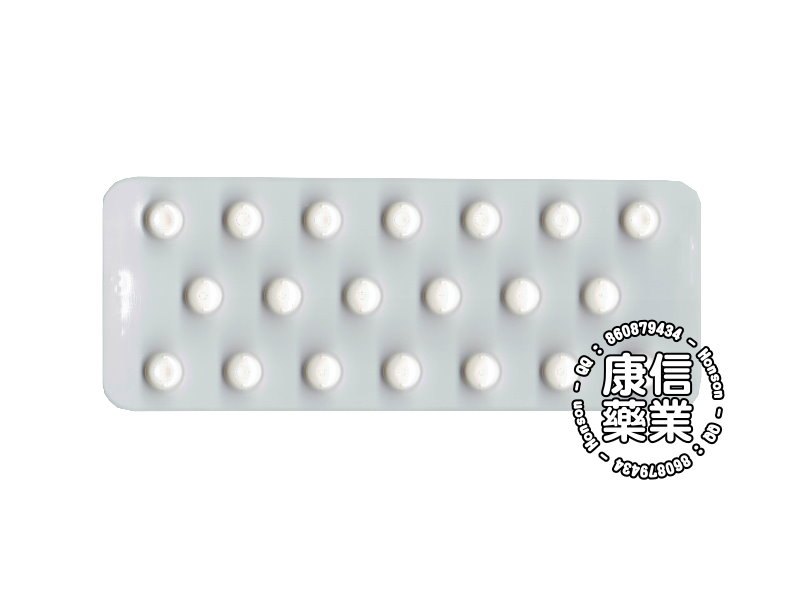
Dulcolax
Model: T0806
Product Description
Dulcolax
(bisacodyl)
Composition
1 coated tablet contains 5 mg
4,4,-diacetoxy-diphenyl-(pyridyl-2)-methane (= bisacodyl) Indications
For use in patients suffering from constipation.
For preparation of diagnostic procedures, in pre- and postoperative treatment and in conditions, which require defecation to be facilitated.
Dosage and administration
Unless otherwise prescribed by the physician, the following dosages are recommended:
For constipation
Coated tablets
Adults and children over 10 years: 1-2 coated tablets
(5-10 mg)
Children 4 -10 years: 1 coated tablet(5mg)
Children aged 10 years or younger with chronic or persistent constipation should only be treated under the guidance of a physician.
It is recommended to take the coated tablets at night to have a bowel movement the following morning. They should be swallowed whole with an adequate amount of fluid.
The coated tablets should not be taken together with products reducing the acidity of the upper gastrointestinal tract, such as milk, antacids or proton pump inhibitors, in order not to prematurely dissolve the enteric coating.
For preparation of diagnostic procedures and preoperatively
For preparation of diagnostic procedures, in pre- and postoperative treatment and in medical conditions which require defecation to be facilitated, DULCOLAX® should be used under medical supervision.
In order to achieve complete evacuation of the intestine the DULCOLAX® dosage recommended for adults is two to four coated tablets the night before the examination, followed by an immediate relief laxative (e.g. suppository) in the morning of the examination.
For children 4 years of age and over, one coated tablet in the evening and a paediatric immediate relief laxative (e.g. suppository) on the following morning is recommended.
Contraindications
DULCOLAX® is contraindicated in patients with ileus, intestinal obstruction, acute abdominal conditions including appendicitis, acute inflammatory bowel diseases, and severe abdominal pain associated with nausea and vomiting which may be indicative of severe conditions.
DULCOLAX® is also contraindicated in severe dehydration and in patients with known hypersensitivity to bisacodyl or any other component of the product.
In case of rare hereditary conditions that may be incompatible with an excipient of the product (please refer to “Special Warnings and Precautions”) the use of the product is contraindicated.
Special warnings and precautions
As with all laxatives, DULCOLAX® should not be taken on a continuous daily basis or for extended periods without investigating the cause of constipation.
Prolonged excessive use may lead to fluid and electrolyte imbalance and hypokalaemia.
Intestinal loss of fluids can promote dehydration.
Symptoms may include thirst and oliguria. In patients suffering from fluid loss where dehydration may be harmful (e.g. renal insufficiency, elderly patients) DULCOLAX® should be discontinued and only be restarted under medical supervision.
Patients may experience haematochezia (blood in stool that is generally mild and self limiting.
Dizziness and/or syncope have been reported in patients who have taken DULCOLAX®. The details available for these cases suggest that the events would be consistent with defecation syncope (or syncope attributable to straining at stool), or with a vasovagal response to abdominal pain related to the constipation, and not necessarily to the administration of bisacodyl itself.
Children should not take bisacodyl without medical advice.
One coated tablet contains 33.2 mg lactose, resulting in 66.4 mg lactose per maximum recommended daily dose for treatment of constipation in adults and children over 10 years of age. For radiographic examination this will result in 132.8 mg per maximum recommended daily dose in adults. Patients with rare hereditary conditions of galactose intolerance, e.g. galactosaemia, should not take this medicine.
One coated tablet contains 23.4 mg sucrose (saccharose), resulting in 46.8 mg sucrose (saccharose) per maximum recommended daily dose for treatment of constipation in adults and children over 10 years of age. For radiographic examination this will result in 93.6 mg per maximum recommended daily dose in adults. Patients with the rare hereditary condition of fructose intolerance should not take this medicine.
The concomitant use of diuretics or adreno-corticosteroids may increase the risk of electrolyte imbalance if excessive doses of DULCOLAX® are taken.
Electrolyte imbalance may lead to increased sensitivity to cardiac glycosides.
Fertility, pregnancy and lactation
There are no adequate and well-controlled studies in pregnant women. Long experience has shown no evidence of undesirable or damaging effects during pregnancy.
Nevertheless, as with all drugs, DULCOLAX® should be taken during pregnancy only on medical advice.
Clinical data show that neither the active moiety of bisacodyl BHPM (bis-(p-hydroxyphenyl)- pyridyl-2-methane) nor its glucuronides are excreted into the milk of healthy lactating human females.
No studies on the effect on human fertility have been conducted.
Effects on ability to drive and use machines
No studies on the effects of DULCOLAX® on the ability to drive and use machines have been performed.
However, patients should be advised that due to a vasovagal response (e.g., to abdominal spasm) they may experience dizziness and/or syncope. If patients experience abdominal spasm they should avoid potentially hazardous tasks such as driving or operating machinery.
Side effects
The most commonly reported adverse reactions during treatment are abdominal pain and diarrhoea.
Adverse events have been ranked under headings of frequency using the following convention: Very common (> 1/10); common (> 1/100, < 1/10); uncommon (> 1/1000, <1/100); rare (i 1/10000, <1/1000); very rare (<1710000).
Frequency
Immune system disorders
Anaphylactic reactions, angioedema,hypersensitivity
Rare
Metabolism and nutrition disorders
Dehydration
Rare
Nervous system disorders
Dizziness
Syncope
Dizziness and syncope occurring after taking bisacodyl appear to be consistent with a vasovagal response (e g., to abdominal spasm, defecation).
Uncommon
Rare
Gastrointestinal disorders
Abdominal cramps, abdominal, pain, diarrhoea, nausea
Abdominal discomfort, anorectal discomfort, haematochezia, vomiting
Colitis
Common Uncommon
Rare
Overdose
Symptoms
If high doses are taken watery stools (diarrhoea), abdominal cramps and a clinically significant loss of fluid, potassium and other electrolytes can occur.
DULCOLAX®, as with other laxatives, when taken in chronic overdose may cause chronic diarrhoea, abdominal pain, hypokalaemia, secondary hyperaldosteronism and renal calculi. Renal tubular damage, metabolic alkalosis and muscle weakness secondary to hypokalaemia have also been described in association with chronic laxative abuse.
Therapy
After ingestion of oral forms of DULCOLAX®, absorption can be minimised or prevented by inducing vomiting or gastric lavage. Replacement of fluids and correction of electrolyte imbalance may be required. Tms is especially important in the elderly and the young.
Administration of antispasmodics may be of value.
Pharmacological properties
Bisacodyl is a locally acting laxative from the diphenylmethane derivatives group. As a contact laxative, for which also antiresorptive hydragogue effects have been described, bisacodyl stimulates, after hydrolysis in the large intestine, peristalsis of the colon and promotes accumulation of water, and consequently electrolytes, in the colonic lumen. This results in a stimulation of defecation, reduction of transit time and softening of the stool.
Availability
Coated tablets of 5 mg
Boehringer Ingelheim GmbH
Store in a safe place out of the reach of children!

